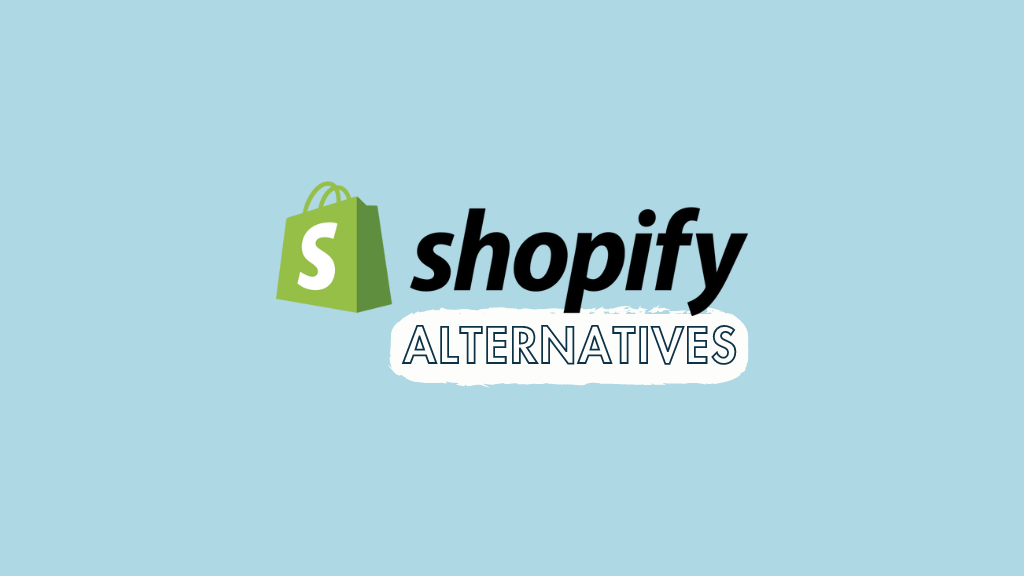
Shopify is one of the best hosted store builders available — arguably the best. However, before deciding on the right ecommerce solution for your project, it’s a good idea to check out the competition! So in this post we spell out the key Shopify alternatives to consider, along with their pros and cons.
1. BigCommerce
BigCommerce is perhaps the most obvious alternative to Shopify. Like Shopify, it is a platform that was designed specifically with ecommerce in mind — unlike most of the competing ecommerce platforms mentioned in this post, it didn’t start life as a ‘general purpose’ website builder.

Accordingly, it has a similar feature set to Shopify — if a much smaller userbase and app store — and is priced similarly too.
The main argument for using BigCommerce over Shopify is that quite a lot of selling features that require the addition of an app in Shopify are provided ‘out of the box’ by BigCommerce.
These include:
- larger product option limits
- digital downloads
- the option to let users customize their purchases more extensively at checkout.
Additionally, there are no transaction fees to worry about with BigCommerce.
(Shopify charges these if you use a third-party payment processor, rather than its own ‘Shopify Payments’ processor).

You can learn more about the differences between BigCommerce and Shopify in our BigCommerce vs Shopify comparison, or alternatively, read our BigCommerce review.
2. Wix
Although it started life as a ‘general’ website builder rather than an ecommerce platform, Wix has steadily been adding ecommerce functionality over the years and it now boasts a pretty comprehensive range of selling tools.

While these ecommerce features are not yet as sophisticated as Shopify’s — particularly where selling in multiple currencies is concerned — they are easy to use and let you sell a wide range of physical items, digital goods and access to video content.
The main argument for using Wix over Shopify is that the platform gives you much more control over content presentation than its rival.
It gives you:
- far more free templates (831 vs Shopify’s 13)
- better blogging features
- autosave features
- a wide range of options for presenting images and designing forms that are not available in Shopify without the purchase of a third-party app
- more control over the appearance of both the desktop and mobile version of your site, thanks to a more flexible drag and drop editor
- the option to translate your store into more languages.
For professional or corporate ecommerce applications, I’d still be inclined to look towards Shopify — it’s the much more scalable solution.
However, small businesses and individuals with a low budget, simple needs and a desire to have more control over their content layout may find Wix an attractive option.
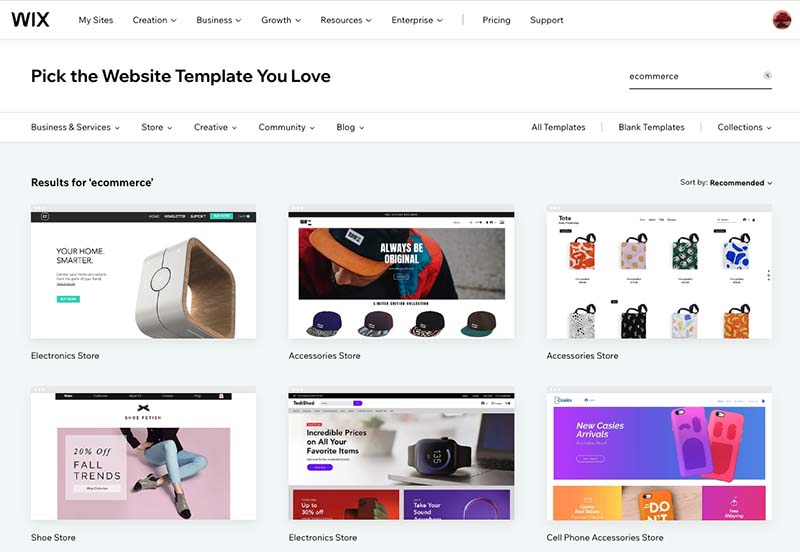
For more information about how Wix stacks up against Shopify, read our Wix vs Shopify comparison or check out our full Wix review.
3. Squarespace
Like Wix, Squarespace started life as a general-purpose website building tool — however, it now boasts an impressive ecommerce feature set and lets you sell products easily online.
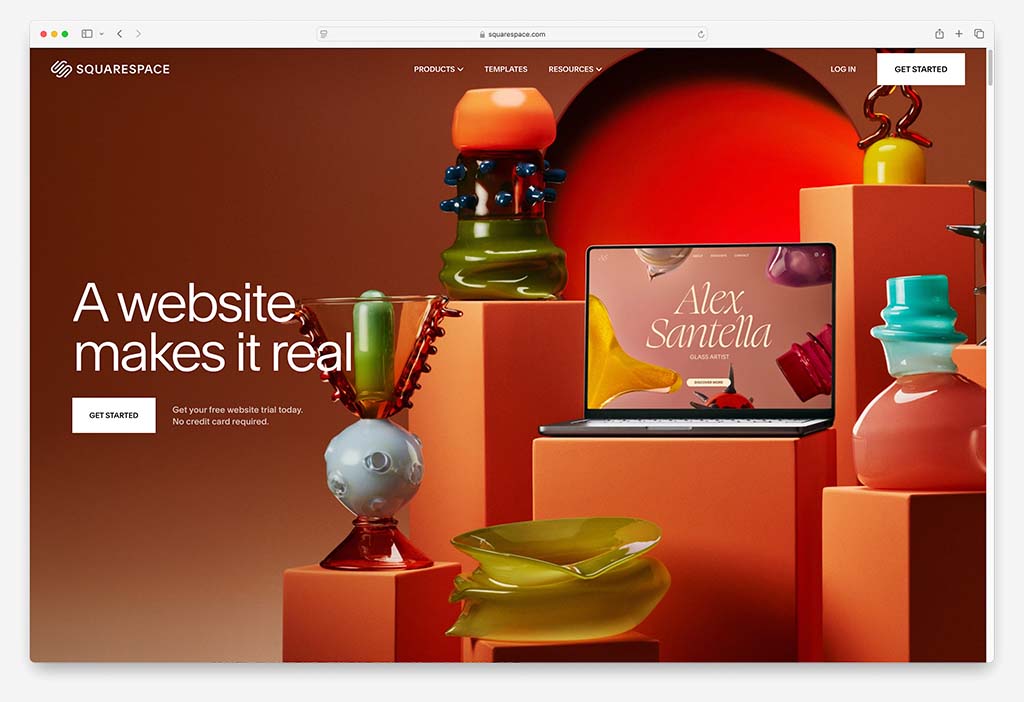
Squarespace wins over Shopify when it comes to:
- templates — they are stunning, arguably best in class, and there are more of them (175 to Shopify’s 13).
- control over content — you can style just about any element on your site extensively and easily
- product options and variants — the limits for both are much more generous than Shopify’s
- creating members areas and selling online courses — Squarespace has a dedicated feature for selling access to gated content (albeit one that comes at an extra cost).
- custom domain names — if you pay annually, Squarespace gives you a free domain name with your plan (www.yoursitename.com etc.). Shopify doesn’t.
However, it is not a good choice for those who wish to sell internationally, as multi-currency selling is not supported; and by comparison to Shopify, its ecommerce tools in general are a bit underpowered (particularly where point of sale is concerned).
But if you need a stunning, highly-editable site that lets you do some selling too, Squarespace may work out as a better choice for you.
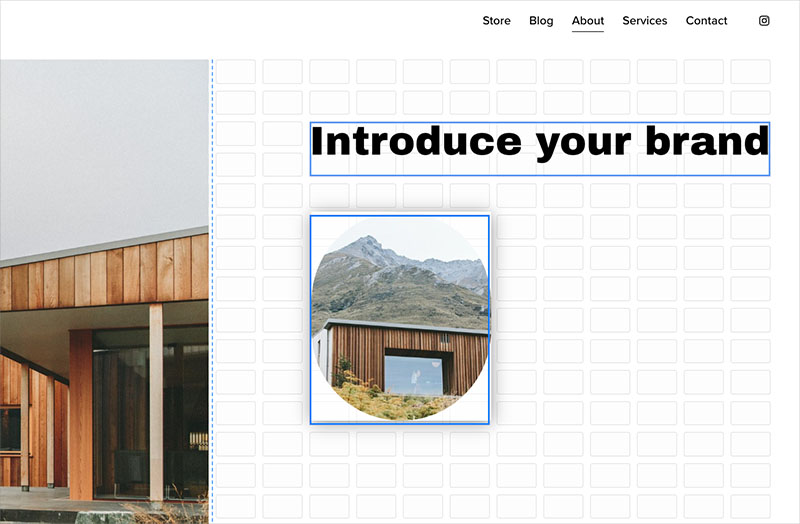
Learn more about the differences between Shopify and Squarespace in our Shopify vs Squarespace comparison, or by reading our full Squarespace review.
While you’re here, check out our store builder finder tool

Our new store builder finder tool helps you find the right ecommerce platform for your needs. Simply answer a few questions about your requirements and get a personalized recommendation that’s right for you.
4. WordPress / WooCommerce
WordPress comes in two flavors: hosted and self-hosted.
The hosted version — available at wordpress.com — is, like Shopify, a product that gives you a range of website building features out of the box.
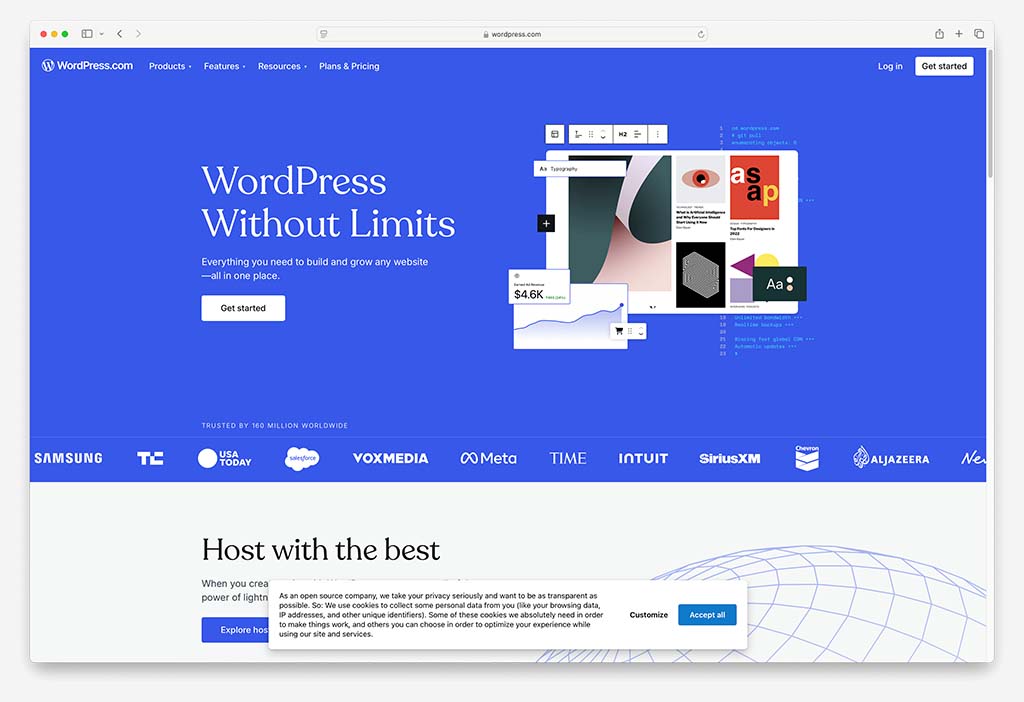
On the more expensive plans, this includes selling features provided via WooCommerce, a very well-featured ecommerce tool that rivals Shopify in many respects.
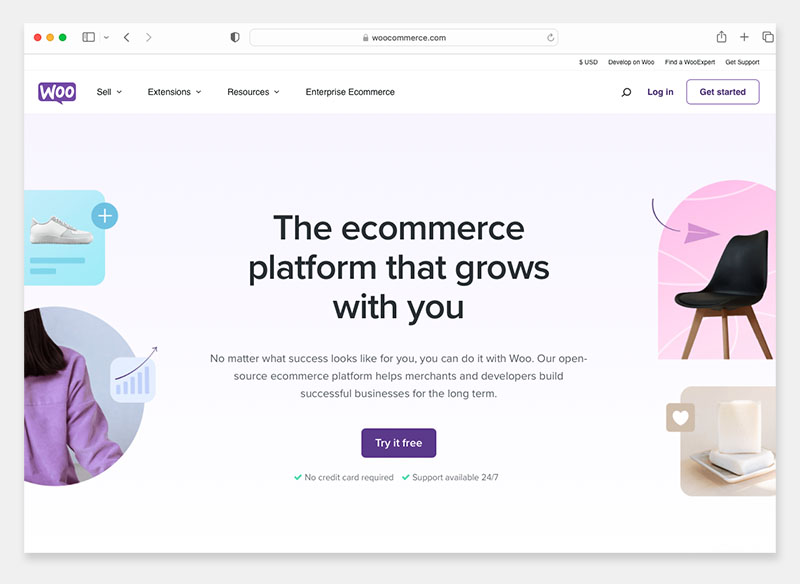
Merchants who are serious about ecommerce usually opt for the self-hosted version of WordPress however – an open source version of the platform that you download for free (from the wordpress.org website) and install on your own hosting setup.

The advantage of using self-hosted WordPress over Shopify is that you have absolute control over everything.
Using the platform, you can:
- pick the exact ecommerce tool you’d like to use (WooCommerce, Ecwid, Easy Digital Downloads etc.)
- code any features you like into your site
- configure your technical SEO setup exactly the way you want it
- choose your own web hosting — you’re not restricted to using a platform’s default hosting but can install WordPress on your own, super-fast web host
- make use of a much wider range of themes (13,000+) or plugins (59,000+) than Shopify.
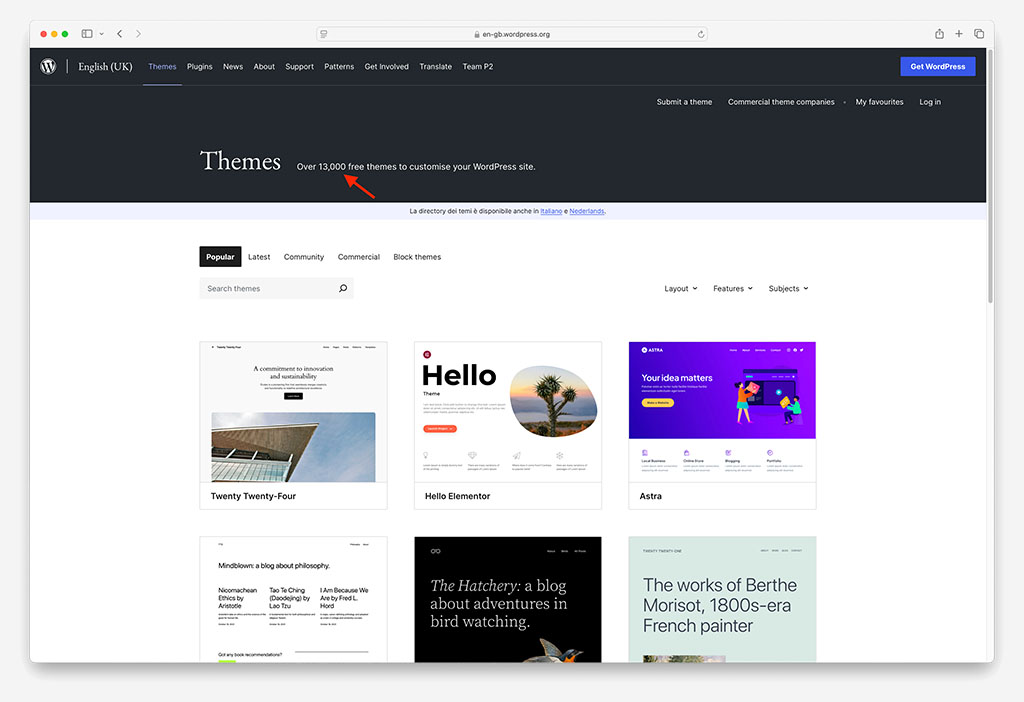
The downside of using self-hosted WordPress over Shopify is more setup time and configuration, plus a steeper learning curve.
And, if you are serious about getting the most out of WordPress from a PageSpeed and technical SEO perspective, there’s often quite expensive hosting involved and (depending on your own technical skills) development work to pay for.
Read our Shopify vs WordPress comparison for more details on how these two platforms stack up against each other, or check out our new WooCommerce vs Shopify comparison to see how Shopify stacks up against the leading ecommerce plugin for WordPress.
5. PrestaShop
PrestaShop was founded by French software engineers Igor Schlumberger and Bruno Lévêque in 2007. Like WordPress and WooCommerce (see above) it is an open source platform, meaning that anyone can edit its source code. This makes it a highly-customizable solution.

PrestaShop comes in two versions: a free version, PrestaShop Classic, which you install, host, and manage on your own server, and a paid-for version, PrestaShop Hosted, which bundles the software and hosting together (with the software pre-installed for you).
Both versions essentially offer the same feature set, with the hosted version being more comparable to Shopify (as it’s a fully-hosted solution involving a monthly fee).
Like Shopify, PrestaShop is a particularly good solution for multi-currency and multilingual selling; its tax rate calculation tools are good too. It also has an edge over Shopify when it comes to user accounts — it offers an unlimited number of these (by contrast, Shopify limits access to your store to just a few users, even on its most expensive plans).
Shopify beats PrestaShop however when it comes to user-friendliness — the learning curve in PrestaShop is considerably steeper.
You can get a detailed picture of how the two platforms compare in our full Shopify vs Prestashop shootout or by watching our YouTube comparison of the two platforms below.
6. Square
Square started life as a point-of-sale (POS) solution for accepting in-person transactions (i.e., in ‘brick and mortar’ stores).
But — aided by the acquisition of the website building tool Weebly, whose technology the platform now incorporates — it has now developed into a solution that lets you build an online store too.
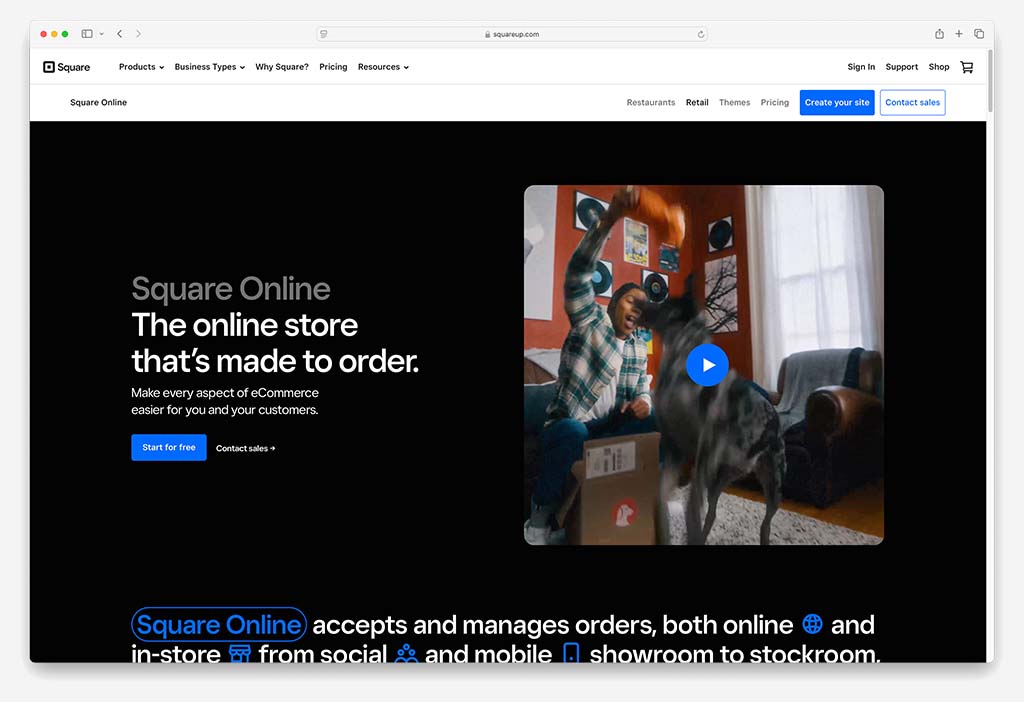
Square’s store builder — officially called ‘Square Online’ — is not as sophisticated as Shopify’s, particularly where international selling tools are concerned, but it does have a key advantage over it, in that it can be used entirely for free (albeit with several important features missing).
Similarly, the Square POS system can be used without any monthly fees being applied — you just pay transaction fees on a per-sale basis, which may appeal to startups without much in the way of a budget. To use POS with Shopify, you will always need to pay for a monthly subscription to the platform.
Square places a particular focus on servicing restaurant owners, and comes with special features that make running food and drink businesses easier (for example, table management, tipping and loyalty card functionality can all be availed of with Square).
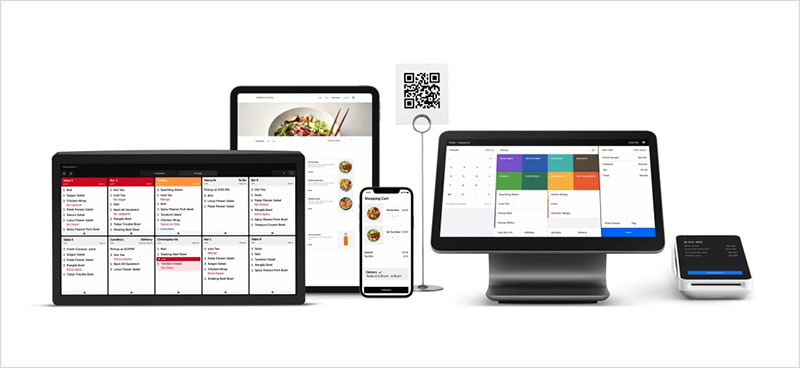
So, if you own a restaurant or a take-out business, you may find Square to be a more ‘natural’ fit than Shopify.
You can learn more about the key differences between Shopify and Square here or find out how the POS features of the two platform compare here.
7. Ecwid
Ecwid started out as a widget for adding ecommerce to any site (hence its name ‘Ec-wid’). And that remains its primary focus — Ecwid gives you a snippet of code that you add to your site to add a comprehensive range of selling features to it.

Although Shopify also lets you do this, via its ‘Buy Button’ feature, the ecommerce features this provides are fairly basic — you can only use a Buy Button to embed products or catalogues on a site. Ecwid’s code snippet, by contrast, installs a fully featured shopping system on it.
In recent years Ecwid also added an ‘Instant Site’ feature that lets you create simple stores that can live on a custom domain (yoursitename.com etc.). Now, these are by no means as fully-featured or sophisticated as Shopify standalone ecommerce stores (not least because they can only contain a few pages), but they are extremely quick and easy to create.
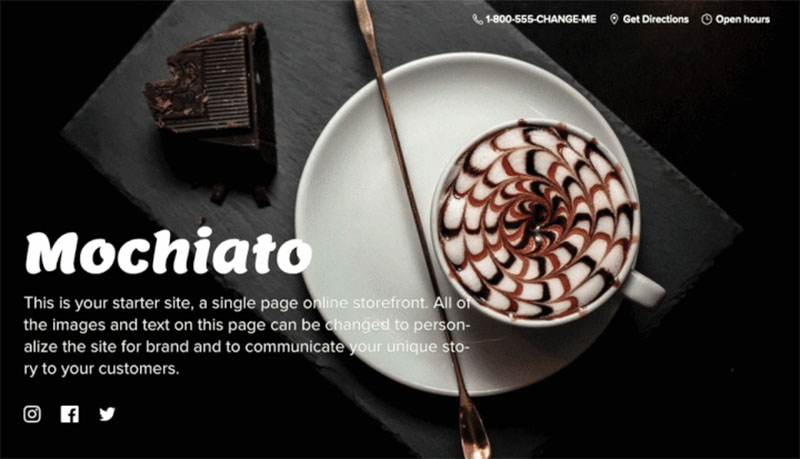
The main advantage that Ecwid provides over Shopify however involves pricing: the platform can actually be used entirely for free. Now Ecwid’s free plan is basic — it limits you to selling 5 products, and only via your own online storefront (i.e., rather than on Facebook, Amazon etc.) — but for merchants with very simple needs, it’s potentially very useful.
Ecwid also is a bit more generous when it comes to product option limits, transaction fees and the size of digital files you can sell.
Overall, Ecwid can be a better choice than Shopify if:
- you are on a very low budget and really need a free selling option
- you are more interested in adding ecommerce to an existing website than creating a brand new one.
If your aim is to build a brand new standalone store though, Shopify remains the more professional choice.
Check out our Ecwid review for more details on the platform, or learn more about the differences between Ecwid and Shopify in our full Ecwid vs Shopify comparison.
8. Big Cartel
Big Cartel is an online store builder that was originally designed to facilitate sales of ‘creative’ products — music, painting, jewellery etc.

From a features perspective, it’s nowhere near as sophisticated as Shopify (particularly when it comes to SEO, dropshipping, point of sale and abandoned cart saving features) but it does offer a couple of advantages over it:
- It can be used for free (so long as you are selling less than 5 items)
- Its paid-for plans are very cheap by comparison to Shopify’s
- It’s extremely easy to use — the learning curve is minimal.
Professional merchants will fare much better with Shopify, but artists and musicians on a low budget (or even without a budget at all) will find much to like in Big Cartel.
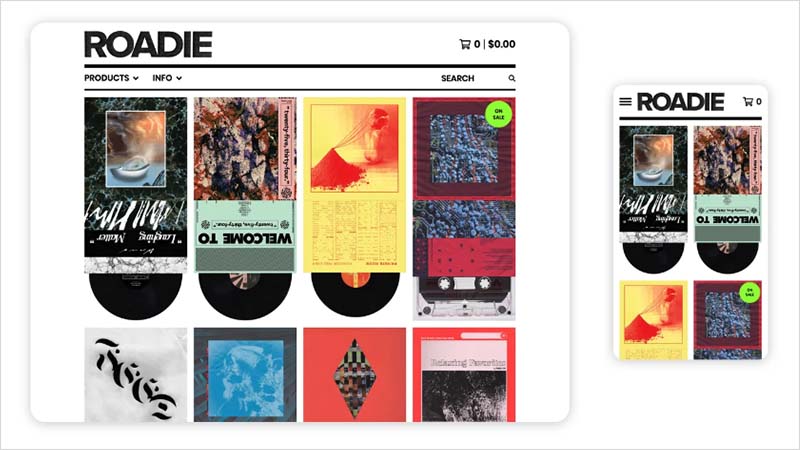
You can learn more about the platform in our Big Cartel review, or find out more about the differences between it and Shopify in our Big Cartel vs Shopify comparison.
9. GoDaddy Website Builder
GoDaddy Website Builder is a popular website building platform that gives you a very good range of basic ecommerce features out of the box.

In most respects it is bettered by Shopify, but there are a few reasons why you might want to consider it instead:
- It’s a little bit cheaper — while Shopify gives you access to an online store building tool from $39 per month, GoDaddy’s commerce costs $34.99 per month.
- No transaction fees are applied by GoDaddy when you use a third-party payment gateway.
- It lets you sell very large digital files (up to 20GB in size — doing this with Shopify requires buying a third-party app).
- You get a lot more free templates with GoDaddy — 272 to Shopify’s 13.
- Its email marketing features are considerably more generous than Shopify’s (in terms of the number of e-newsletters you can send each month — GoDady’s ‘Commerce’ plan lets you send 100,000 emails per month to Shopify’s 10,000).
Our Shopify vs GoDaddy comparison highlights all the other key differences between Shopify and GoDaddy (and our Wix vs GoDaddy shootout and Squarespace vs GoDaddy comparison may also be of interest here).
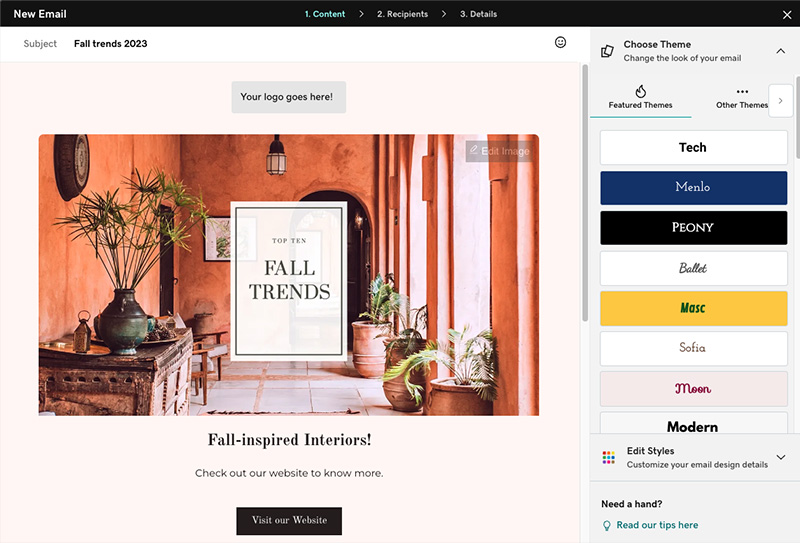
10. Webflow
Webflow has traditionally used as a solution for creating extremely ‘bespoke’ websites that make heavy use of animations and interactive features.

But the platform has recently been getting in on the ecommerce act too, and now offers plans that facilitate online selling. These start at $29 per month when paying for an annual plan — a similar price point to Shopify.
For most merchants however, there isn’t really an argument for using Webflow over Shopify yet. It applies fairly ungenerous limits to the number of items you can sell; doesn’t let you use many payment gateways; and it is not as user-friendly as Shopify (generally speaking, to get the most out of it, some coding knowledge is required).

It does offer more templates than Shopify (and a lot more control over their appearance), but for the vast majority of users, Shopify will prove to be the better ecommerce choice.
You can learn more about Webflow in our Webflow review or see how it compares to Shopify in our Webflow versus Shopify comparison.
11. Printify
Prinitfy may seem like an odd choice to include in a Shopify alternatives roundup — it’s traditionally viewed as a print-on-demand service that you typically integrate with Shopify.
However, if you are looking for an ecommerce solution that you intend to use exclusively for selling print-on-demand items, it’s worth adding the platform to your shortlist. This is because in addition to handling the print on demand side of things for you, Printify comes with a standalone store builder — its ‘Pop-Up Store’ feature.
Now it has to be said that by comparison to Shopify, Printify’s Pop-Up Store feature is a very simple store builder — the customization options are minimal and you won’t be able to map the store you build with it to a custom domain.
But the Pop-Up Store builder does make the process of launching a basic POD store extremely quick, and without there being any transaction fees or ongoing monthly dees to worry about.
You can learn more about the feature (and Printify in general) in our full Printify review or our YouTube video review of the platform.
12. Amazon
So far in this post I’ve discussed a range of Shopify alternatives that let you build an online store. Amazon differs from these, because it IS an online store — and a huge one at that!
But you can still use it to sell products on, and the main advantage of doing this rather than building a Shopify store is that you are gaining access to a ready-made (and enormous) audience of Amazon shoppers.

The other advantage of using Amazon over Shopify is that you don’t have to worry that much about web design tasks — domain registration, graphic design, navigation design, UX, copywriting and so on.
This is because with Amazon, you’re just listing your products on an existing website — not building an entirely new one.
The downsides of using Amazon over Shopify are that you have far less control over your brand and less opportunities for content marketing, and it’s also not remotely as good for dropshipping.
But since Shopify and Amazon can be made to work well together (via an official ‘Buy with Prime for Shopify’ app and also a selection of third party apps that are available from Shopify’s app store), it’s usually in merchants’ interests to sell on both platforms.
You can learn more about the differences between Shopify and Amazon (and how to use both together) in our Shopify vs Amazon comparison.
13. eBay
Like Amazon, eBay is not an online store builder but an online marketplace. It brings with it a similar advantage over Shopify, namely access to a huge existing audience of shoppers.
The other key advantage of using eBay over Shopify is that if you want to run auctions, it’s a much better tool; additionally, so long as you’re listing less than 250 items on your eBay store, there are no monthly fees to worry about (but that said, commission will be applied on any sales).

As with Amazon, eBay and Shopify can be made to work together via apps that sync product inventory and listings, so a lot of merchants opt to use the two platforms in tandem with each other.
You can compare and contrast the two platforms in more depth in our Shopify vs eBay comparison.
14. Etsy
Etsy is another online marketplace that you can use as an alternative to Shopify to sell your products on.

But it’s a bit different to Amazon and eBay, because you can use Etsy not just to list your products in a marketplace but to build a standalone store too, via its dedicated ‘Pattern by Etsy’ store building app.
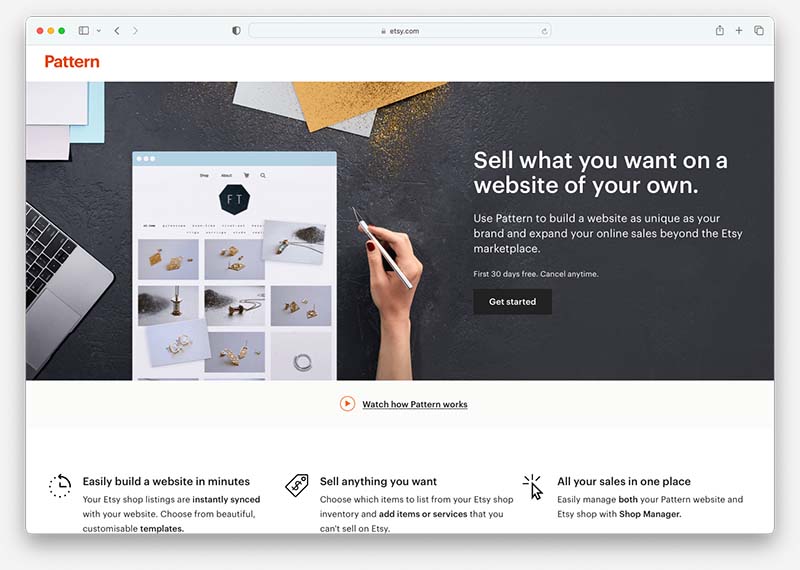
The main advantage of selling on Etsy’s marketplace rather than via a standalone Shopify store is — as is the case with Amazon and eBay — the access to an existing audience of consumers.
Unlike Amazon and eBay’s audience however, Etsy’s is a ‘niche’ one — one that is primarily interested in handcrafted, personalized or vintage goods. So, if you are hoping to sell those sorts of products, there is definitely a case to be made for using Etsy.
As for Etsy’s ‘Pattern’ store builder, this is a much less scalable and sophisticated ecommerce solution than Shopify — but it is significantly cheaper (it costs $15 per month, $24 cheaper than Shopify’s ‘Basic’ plan for building an ecommerce store) and it integrates very neatly with Etsy.
You can integrate a Shopify store with Etsy easily enough via a third-party app however, and many merchants opt for this ‘best of both worlds’ approach to both platforms (see my screenshot below for a few examples of available integrations).
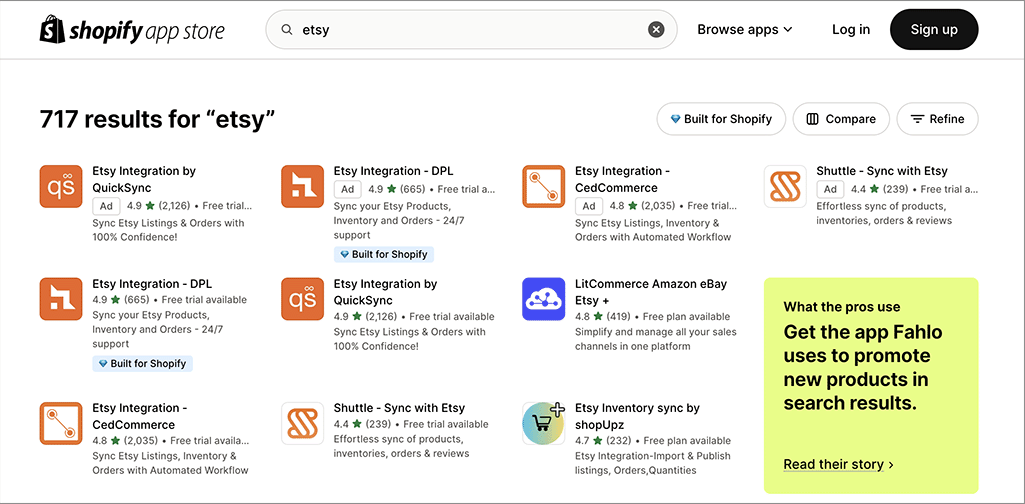
You can learn more about the key differences between the two tools in our Shopify vs Etsy comparison.
15. ClickFunnels
ClickFunnels is a sales funnel builder designed to help businesses automate their online marketing and sales processes. The platform allows users to create landing pages, sales pages, order forms, and membership sites; it also facilitates automated triggering of emails based on what users do on all the aforementioned.
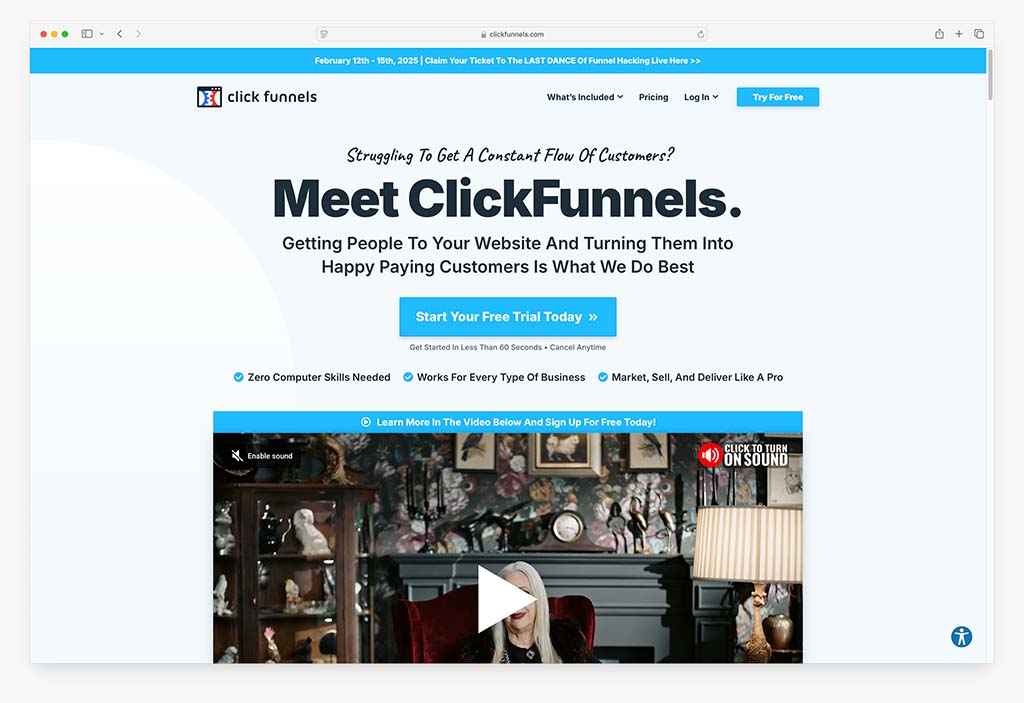
Additionally, it gives you access to a website building tool and an online course selling tool, meaning that it can be viewed as a direct alternative to Shopify.
If you want access to a tool that gives you tools specifically for creating sophisticated sales funnels — and comes with upsell, downsell and split testing features out of the box — ClickFunnels can work great for you. This is especially the case if you are mainly trying to sell just one or two products and don’t really need a standalone website to showcase hundreds of them.
Shopify remains the better bet however for merchants with large catalogues and those who wish to sell in multiple currencies. The quality of its templates is higher too.
You can learn more about ClickFunnels and how it stacks up against Shopify in our ClickFunnels vs Shopify comparison; alternatively, check out our ClickFunnels review.
Some other Shopify alternatives to consider
The ecommerce platform market is very big, and growing fast! Some other Shopify competitors that you might wish to consider when setting up a side hustle or professional ecommerce business include:
- Adobe Commerce (formerly Magento)
- Easy Digital Downloads (WordPress plugin; for selling digital products only)
- Dukaan
- EKM
- OpenCart
- PinnacleCart
- Salesforce Commerce
- Sellfy
- Shift4Shop (formerly 3dCart)
- Strikingly
- Volusion
- X-Cart
- Zoho Commerce
We have yet to review all of these but are gradually working our way through the list! Stay posted to our ecommerce platform reviews section for all our latest reviews of ecommerce software and comparisons of the most popular ecommerce platforms.
You may also find our guides to Wix alternatives, Squarespace alternatives and Webflow alternatives helpful.
Free ecommerce kit 🖥️💰
While you’re here, check out our free ecommerce kit. It’s packed with useful resources on setting up an online business, along with trials and offers for popular ecommerce apps.
Shopify alternatives FAQ
Below you’ll find some frequently asked questions about competitors to Shopify.
Who are Shopify’s main competitors?
When it comes to hosted online store builders, the main competitors in terms of userbase size are probably Wix and Squarespace. In terms of features, the most similar product we’ve tested is BigCommerce. WooCommerce is also a key competing product, with a huge userbase — but this is a WordPress plugin (rather than a standalone store building tool).
Is Shopify the best ecommerce platform?
It’s certainly one of the best – it’s easy to use, feature packed and highly scalable, and is considered by many to be the ‘industry standard’ solution for building a store (particularly a dropshipping store). The main criticism of Shopify is that gaining key functionality for the platform often requires the purchase of a third-party app, which can increase monthly costs.
Are there any free alternatives to Shopify?
Two key competing ecommerce platforms that you can use entirely for free are Big Cartel and Ecwid. However, their free plans are very basic and limit you to selling just a few products. That said, if your needs are very simple, they represent a good entry point into the world of ecommerce.
What are the main advantages of Shopify?
The main advantages of Shopify are that it’s easy to use, feature-rich, highly scalable and great for multilingual and multi-currency selling.
What are the main disadvantages of Shopify?
The main disadvantages of Shopify are that it only comes with a few bundled themes; gaining key features often requires purchasing an app; product options are limited; and transaction fees apply if you use a third-party payment processor.
More Shopify and ecommerce resources from Style Factory
Now over to you! Have you got any queries about Shopify’s competitors, or thoughts of your own about what the best Shopify alternative is? Just leave them in the comments section below — we read all questions and will do our best to help you build a successful ecommerce store.
No comments